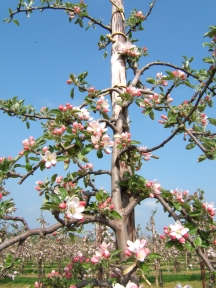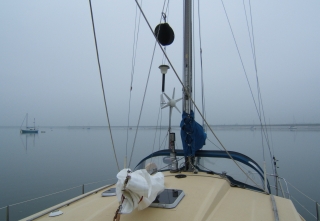But even the Met Office (working flat out as they do just for our benefit) cannot always get the weather right. So at the point when this picture was taken, our last view back at the Thames with a ship at anchor and the low hills of Sheppey just visible in the haze, our sailing plan included stopping for one night attached to Essex (by anchor) before we moved on north into Suffolk. Then the wind freshened and Cirrus started to move faster... and then faster... until our plans changed. So if it was ever our plan to sail around Britain stopping at each county bordering the sea, which it wasn't, then it isn't now, if you see what I mean.
Most sailing boats, and catamarans are no exception, go best on a 'beam reach', that is when the wind is blowing at right angles to the direction of travel. Somewhere off the Maplin Sands with the low-lying coastline of Essex barely visible on the horizon, we picked up a fresh south-easterly and Cirrus began to blast along so fast that we could consider sailing much further than planned that day.
Twice, in fact, the plan changed until many hours later our bows pointed north into the River Deben in Suffolk, a favourite of ours from many years ago when we lived in a village nearby. All that was left was to negotiate the Deben bar, a shallow sill in the mouth of the river over which the sea boiled and foamed. Cirrus undertook the passage through this lot, marked by tiny buoys, at around 7.30pm with daylight fading, the incentive being one of the most beautiful anchorages imaginable just up river. Here we lie with not a boat in sight, remote enough from urbanism that the night is truly dark, the sky full of stars and the only sound is of water lapping our hulls.
Well that was yesterday.
Today we set off exploring to find yet another 11th century church overlooking the river, very plain inside, stained glass looking more like you might expect in the front door of your house, but a cool and quiet place. The round tower has an even earlier history as apparently our Saxon ancestors used this as a vantage point to check for Viking invaders sailing up the river. How anyone alive today can say this with so much certainty is a mystery to me but the position of the tower certainly gives a good view down river and out to sea.
The whole river is steeped in history, most of which has been lost by the draining of the surrounding marshland which made the river narrower and less suitable for larger craft. We did find one remnant of an earlier time however, a small model speedboat perched in the crook of a tree just on the high water line, badly damaged and no doubt once treasured, its last voyage long forgotten.
We are conscious of the fact that it is still very early in the year and many boats are still laid up, yachties only dreaming about sailing them. Many of the moorings we pass are empty, waiting for their boats to arrive, and at sea the sight of a sail is something to be remarked on, a rarity even.
At the weekend, however, with the sun shining, the boats do emerge. The Deben is host to many sailing clubs whose members all want to blow the winter's dust off their dinghies and try their hand at a race, or maybe just fly about in the fresh breeze blowing up the river. They come in all colours and shapes, even this one which bears the same name as us, minus the 'Cat', of course until the river is flecked by clouds of sails all bending to the breeze.Now for some wildlife bits.
We are anchored at a bend in the river known as The Rocks, named after some loose bolder-y bits lying on the bottom below the water. There is a steep sandy bank on the shore with a copse of tall trees which break the wind's strength making it a good spot to anchor providing you are not scared by weird noises. For the trees here provide nesting sites for herons, who seem to prefer tall conifers, and with the river right by giving them a sort of MacDonalds on their doorstep. Herons have a strange vocabulary. All day long the nest-bound chicks emit a repetitive deep clacking sound, continuous and boring (unless you happen to be a heron, of course) and only varying when a parent arrives at the nest. The best way to describe the noise they then make is to imagine someone being violently sick; yes, that noise, very loud and disconcerting.
The final noise coming from these woods is a really scary one, especially since we have only heard this at night. For this you have to imagine a small creature being killed in the most gruesome way imaginable so that their shriek of pain pierces the night. That's the noise.
One final tip on herons: Don't walk beneath their nests. With a creature this size the droppings are dinner-plate sized.













